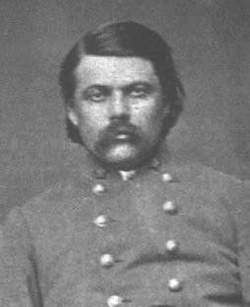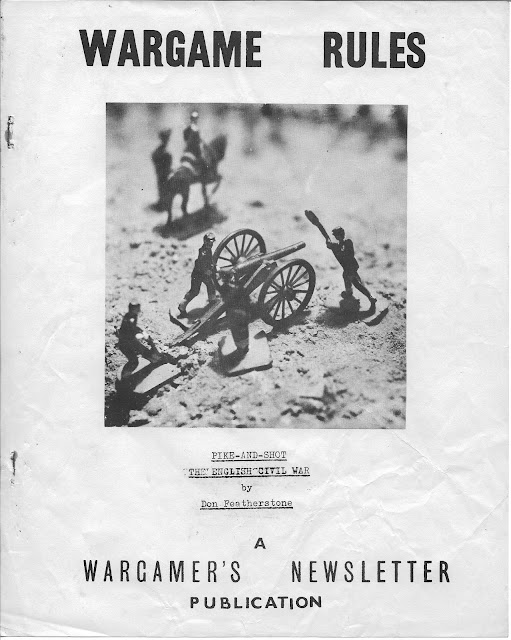 DG and I are into our 3rd or 4th game of DBN of the year (albeit virtually,
and via
Battle Chronicler [clicky]) but there's no comparison with getting some metal on the table, and for a
quick solo game there's no beating One Hour Wargames.
DG and I are into our 3rd or 4th game of DBN of the year (albeit virtually,
and via
Battle Chronicler [clicky]) but there's no comparison with getting some metal on the table, and for a
quick solo game there's no beating One Hour Wargames.
In the delightful walk through of the scenario's, we're now up to no. 22, and
another one of those lovely mismatched scenario's that give a challenge, both
on the table, and in solo play..
It was a toss up which period to use for this game, I was thinking either ACW
or ECW as I've added units to both projects this year and it's always nice to
see them on the table, but given the last OHW game I played was with the ACW
troops, I plumped for ECW for this game..
No spoilers (after 21 reports you should have got the message by now and
already bought the book!  )
)
 )
)
So a mismatched scenario - in this game Parliament are besieging a fortified
manor house held by a small Royalist garrison, but unbeknown to them, there is
a Royalist relief force about to make it's devastating presence known..
Forces were diced for on the random table as written in the book, with the
single exception that the skirmisher/levy/zouave column was replaced with
dragoons, as none of the troop types fitted the ECW period we were playing in. All troops are "regular" (so +1 morale) but just for a little variety/fun, strength points were decided by random (2D6 halved and any half points rounded up).
Parliament OOB:
- CinC - Charles Essex
- 4 Regiments of infantry - Charles Essex's brigade
- 1 regiment of cavalry (Trotter class) - Sir John Gramson's Regiment (naturally!)
- 1 unit of dragoons
| Unit | SP's | MP's |
| Sir Charles Essex's Regiment of Foote | 4 | 5 |
| Sir Henry Cholmley's Regiment of Foote | 6 | 7 |
| Lord Mandeville's Regiment of Foote | 5 | 6 |
| Lord Wharton's Regiment of Foote | 4 | 5 |
| Sir John Gramson's Regiment of Cavalry | 4 | 5 |
| Col. James Wardlowe's Dragoons | 4 | 5 |
 |
| Parliamentary OOB |
Royalist OOB:
- CinC - Sir John Belayse
- 2 regiments of foot - being most of John Belasyse's Brigade (Pennyman's are absent)
- 1 piece of artillery - a Falcon - which will form the garrison of the fortified manor
- 1 unit of dragoons
| Unit | SP's | MP's |
| John Belasyse's Regiment of Foote | 4 | 5 |
| Thomas Blagge's Regiment of Foote | 6 | 7 |
| Garrison artillery (Falcon/Light) | 2 | 3 |
| Colonel John Innes's Dragoons | 3 | 4 |
Rules are my homegrown one's (which you can find
here [clicky])
Table as follows... fortified manor house upper left quarter - woods (open) cover the bottom of the table... no hills other than the one the manor house is on, all going other than the wood and that hill is good (so fields are just for show)..
Initial dispositions were as follows, and the Royalist plan of action was very simple "kill the mostest the soonest" to paraphrase another Civil War general.. the scenario allows a period of surprise where the Parliamentary forces cannot react in any way, while the numerically inferior Royalists have to inflict as much damage as possible on the bigger Parliamentary force..
 |
| Royalist strike/relieving force deployed at the edge of the woods to the left |
Launching their attack from the wood, the Royalist troops swept down like a howling banshee on the unsuspecting Parliamentary troops. The Royalist Dragoons inflicted the first casualties causing, Lord Mandeville's to break and run in panic (they failed their "test to stand" upon being contacted, and as a resulted routed and took a strength point hit) - one down, five to go..
Next blood went to Sir Tomas Blagge's, who similarly caught the Parliamentary dragoons napping and did the same to them! Two down, four to go...
 |
| "Snake eyes dammit, err.. beggin' your pardon father"... |
No Parliamentary moving or firing and it only remained for the Royalist artillery to throw snake eyes to end the turn.. all in all a good start for the Royalists but surely it can't continue!?
On to turn 2 then, and the victorious Royalist dragoons charge on and hit Wharton's in the flank, while Blagge's do the same to Charles Essex's. Both Parliamentary units fail their tests (all of the Parliamentary units were throwing high which is the very opposite of what they needed) and break and run... end the turn with the Royalist artillery throwing snake eyes again and it was a bit if a sublime to the ridiculous. Four down and two to go!
 |
| Start turn 2 - first Parliamentary casualties head for the edge of the table (bottom) |
 |
| Same turn different view.. |
Turn 3 and the Royalists continue their advance - the Dragoons crash into the flank of Sir John Gramson's cavalry regiment while Blagge's march on (their dander well and truly up) and do the same Cholmley's. Gramson's fail their test to stand and rout straight from the table, but in a triumphant first for the forces of Parliament Cholmley's stand! Unhappily though, they are beaten in the melee (flanked and already shaken) and break and rout... six down and none to go... 

 |
| Start turn 4 |
Elsewhere Belayse's finally get into action catching the retreating Charles Essex's who promptly surrender (all routing units automatically fail the 'test to stand' in my rules - they either lose a strength point and continue routing, or surrender...), two of the other routing Parliamentary units also fail their morale checks and rout from the table...
Game over end turn 4...!
 |
| End of game |
Post match analysis:
- The rules played well - nothing in the rules caused the total breakdown of the Parliamentary force... that was just down to poor dice throwing... as I get older the mental narrative of the game becomes more and more important, and in my head I was seeing a cold, damp dawn, with Parliamentary pickets sleepy and unobservant, their compatriots asleep and waiting the battle of the next day safe in their superiority whilst unbeknownst to them Royalist eye's have them under observation from the darkened edge of the woods to their left... "on my command, unleash hell"..

- Despite the ease with which they won the game this is a HARD scenario for the Royalists to win being four to six, the only thing that made this game easier for them was the fact that they got the artillery in the initial random force selection.. they really need to make the most of those first few 'surprise turns'
- I'd forgotten the +1 morale but when I looked back there were only two/three occasions where it would have played a part, and in both cases from memory, the bonus would not have made a difference.
 |
"Blimey.."  |




















